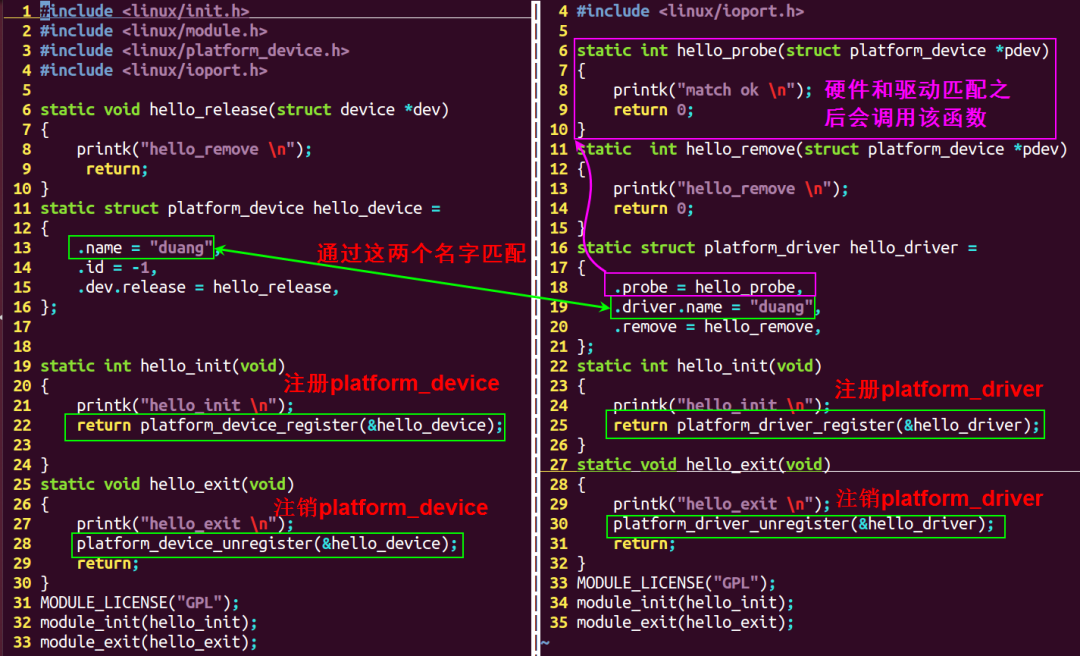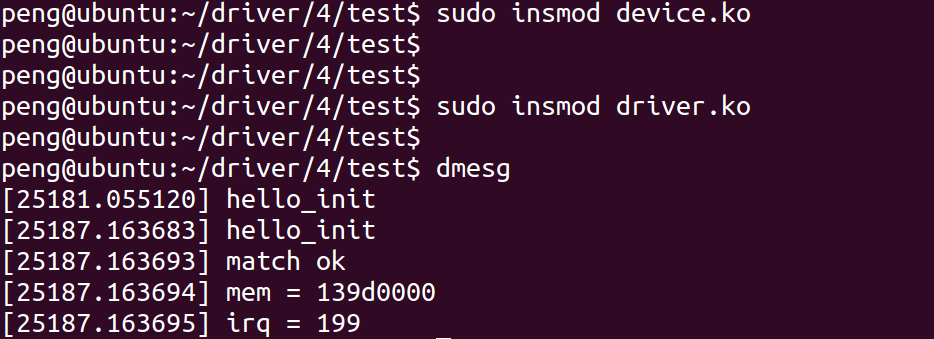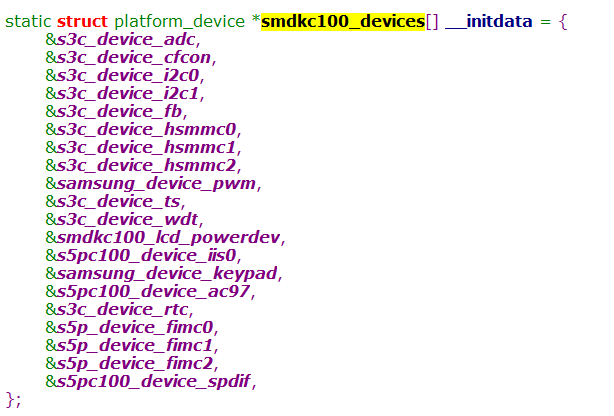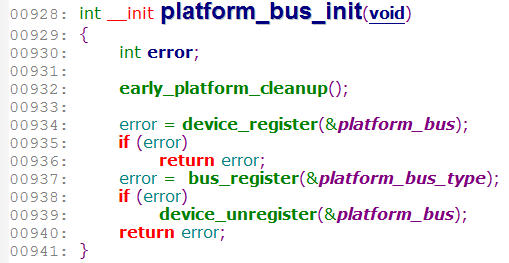platform总线是学习linux驱动必须要掌握的一个知识点。
本文参考已发布:Linux 3.14内核
一、概念
嵌入式系统中有很多的物理总线:I2c、SPI、USB、uart、PCIE、APB、AHB
linux从2.6起就加入了一套新的驱动管理和注册的机制platform平台总线,是一条虚拟的总线,并不是一个物理的总线。
相比 PCI、USB,它主要用于描述SOC上的片上资源。platform 所描述的资源有一个共同点:在CPU 的总线上直接取址。
平台设备会分到一个名称(用在驱动绑定中)以及一系列诸如地址和中断请求号(IRQ)之类的资源。
设备用platform_device表示,驱动用platform_driver进行注册。
与传统的bus/device/driver机制相比,platform由内核进行统一管理,在驱动中使用资源,提高了代码的安全性和可移植性。
二、platform
1. platform总线两个最重要的结构体
platform维护的所有的驱动都必须要用该结构体定义:
platform_driver
structplatform_driver{
int(*probe)(structplatform_device*);//
int(*remove)(structplatform_device*);
void(*shutdown)(structplatform_device*);
int(*suspend)(structplatform_device*,pm_message_tstate);
int(*resume)(structplatform_device*);
structdevice_driverdriver;
conststructplatform_device_id*id_table;
boolprevent_deferred_probe;
};
该结构体,用于注册驱动到platform总线,
| 成员 | 含义 |
|---|---|
| probe | 当驱动和硬件信息匹配成功之后,就会调用probe函数,驱动所有的资源的注册和初始化全部放在probe函数中 |
| remove | 硬件信息被移除了,或者驱动被卸载了,全部要释放,释放资源的操作就放在该函数中 |
| struct device_driver driver | 内核维护的所有的驱动必须包含该成员,通常driver->name用于和设备进行匹配 |
| const struct platform_device_id *id_table | 往往一个驱动可能能同时支持多个硬件,这些硬件的名字都放在该结构体数组中 |
我们编写驱动的时候往往需要填充以上几个成员
platform_device
platform总线用于描述设备硬件信息的结构体,包括该硬件的所有资源(io,memory、中断、DMA等等)。
structplatform_device{
constchar*name;
intid;
boolid_auto;
structdevicedev;
u32num_resources;
structresource*resource;
conststructplatform_device_id*id_entry;
/*MFDcellpointer*/
structmfd_cell*mfd_cell;
/*archspecificadditions*/
structpdev_archdataarchdata;
};
| 成员 | 含义 |
|---|---|
| const char*name | 设备的名字,用于和驱动进行匹配的 |
| struct devicedev | 内核中维护的所有的设备必须包含该成员, |
| u32num_resources | 资源个数 |
| struct resource*resource | 描述资源 |
struct devicedev->release()必须实现,
其中描述硬件信息的成员struct resource
0x139d0000
structresource{
resource_size_tstart;//表示资源的起始值,
resource_size_tend;//表示资源的最后一个字节的地址,如果是中断,end和satrt相同
constchar*name;//可不写
unsignedlongflags;//资源的类型
structresource*parent,*sibling,*child;
};
flags的类型说明
#defineIORESOURCE_MEM0x00000200//内存
#defineIORESOURCE_IRQ0x00000400//中断
内核管理的所有的驱动,都必须包含一个叫struct device_driver成员, //男性描述的硬件,必须包含struct device结构体成员。 //女性
structdevice_driver{
constchar*name;
structbus_type*bus;
structmodule*owner;
constchar*mod_name;/*usedforbuilt-inmodules*/
boolsuppress_bind_attrs;/*disablesbind/unbindviasysfs*/
conststructof_device_id*of_match_table;
conststructacpi_device_id*acpi_match_table;
int(*probe)(structdevice*dev);
int(*remove)(structdevice*dev);
void(*shutdown)(structdevice*dev);
int(*suspend)(structdevice*dev,pm_message_tstate);
int(*resume)(structdevice*dev);
conststructattribute_group**groups;
conststructdev_pm_ops*pm;
structdriver_private*p;
};
其中:
constchar*name;
用于和硬件进行匹配。
内核描述硬件,必须包含struct device结构体成员:
structdevice{
structdevice*parent;
structdevice_private*p;
structkobjectkobj;
constchar*init_name;/*initialnameofthedevice*/
conststructdevice_type*type;
structmutexmutex;/*mutextosynchronizecallsto
*itsdriver.
*/
structbus_type*bus;/*typeofbusdeviceison*/
structdevice_driver*driver;/*whichdriverhasallocatedthis
device*/
void*platform_data;/*Platformspecificdata,device
coredoesn'ttouchit*/
structdev_pm_infopower;
structdev_pm_domain*pm_domain;
#ifdefCONFIG_PINCTRL
structdev_pin_info*pins;
#endif
#ifdefCONFIG_NUMA
intnuma_node;/*NUMAnodethisdeviceiscloseto*/
#endif
u64*dma_mask;/*dmamask(ifdma'abledevice)*/
u64coherent_dma_mask;/*Likedma_mask,butfor
alloc_coherentmappingsas
notallhardwaresupports
64bitaddressesforconsistent
allocationssuchdescriptors.*/
structdevice_dma_parameters*dma_parms;
structlist_headdma_pools;/*dmapools(ifdma'ble)*/
structdma_coherent_mem*dma_mem;/*internalforcoherentmem
override*/
#ifdefCONFIG_DMA_CMA
structcma*cma_area;/*contiguousmemoryareafordma
allocations*/
#endif
/*archspecificadditions*/
structdev_archdataarchdata;
structdevice_node*of_node;/*associateddevicetreenode*/
structacpi_dev_nodeacpi_node;/*associatedACPIdevicenode*/
dev_tdevt;/*dev_t,createsthesysfs"dev"*/
u32id;/*deviceinstance*/
spinlock_tdevres_lock;
structlist_headdevres_head;
structklist_nodeknode_class;
structclass*class;
conststructattribute_group**groups;/*optionalgroups*/
void(*release)(structdevice*dev);
structiommu_group*iommu_group;
booloffline_disabled:1;
booloffline:1;
};
其中:
void(*release)(structdevice*dev);
不能为空。
2. 如何注册
要用注册一个platform驱动的步骤
1)注册驱动platform_device_register
/**
*platform_device_register-addaplatform-leveldevice
*@pdev:platformdevicewe'readding
*/
intplatform_device_register(structplatform_device*pdev)
{
device_initialize(&pdev->dev);
arch_setup_pdev_archdata(pdev);
returnplatform_device_add(pdev);
}
2) 注册设备platform_driver_register
#defineplatform_driver_register(drv)\
__platform_driver_register(drv,THIS_MODULE)
三、举例
1. 开发步骤
platform 总线下驱动的开发步骤是:
设备
需要实现的结构体是:platform_device 。
1)初始化 resource 结构变量
2)初始化 platform_device 结构变量
3)向系统注册设备:platform_device_register。
以上三步,必须在设备驱动加载前完成,即执行platform_driver_register()之前,原因是驱动注册时需要匹配内核中所有已注册的设备名。
platform_driver_register()中添加device到内核最终还是调用的device_add函数。
Platform_device_add和device_add最主要的区别是多了一步insert_resource(p, r),即将platform资源(resource)添加进内核,由内核统一管理。
驱动
驱动注册中,需要实现的结构体是:platform_driver 。
在驱动程序的初始化函数中,调用了platform_driver_register()注册 platform_driver 。
需要注意的是:platform_driver 和 platform_device 中的 name 变量的值必须是相同的【在不考虑设备树情况下,关于设备树,后面会写新的文章详细讲述】 。
这样在 platform_driver_register() 注册时,会将当前注册的 platform_driver 中的 name 变量的值和已注册的所有 platform_device 中的 name 变量的值进行比较,只有找到具有相同名称的 platform_device 才能注册成功。
当注册成功时,会调用 platform_driver 结构元素 probe 函数指针。
实例1
本例比较简单,只用于测试platform_driver 和platform_device是否可以匹配成功。

左边是platform_device结构体注册的代码,右边是platform_driver结构体注册的代码。
platform_driver 定义和注册:
1#include<linux/init.h>
2#include<linux/module.h>
3#include<linux/platform_device.h>
4#include<linux/ioport.h>
5
6staticinthello_probe(structplatform_device*pdev)
7{
8printk("matchok\n");
9return0;
10}
11staticinthello_remove(structplatform_device*pdev)
12{
13printk("hello_remove\n");
14return0;
15}
16staticstructplatform_driverhello_driver=
17{
18.probe=hello_probe,
19.driver.name="duang",
20.remove=hello_remove,
21};
22staticinthello_init(void)
23{
24printk("hello_init\n");
25returnplatform_driver_register(&hello_driver);
26}
27staticvoidhello_exit(void)
28{
29printk("hello_exit\n");
30platform_driver_unregister(&hello_driver);
31return;
32}
33MODULE_LICENSE("GPL");
34module_init(hello_init);
35module_exit(hello_exit);
platform_device定义和注册:
1#include<linux/init.h>
2#include<linux/module.h>
3#include<linux/platform_device.h>
4#include<linux/ioport.h>
5
6staticvoidhello_release(structdevice*dev)
7{
8return;
9}
10staticstructplatform_devicehello_device=
11{
12.name="duang",
13.id=-1,
14.dev.release=hello_release,
15};
16
17
18staticinthello_init(void)
19{
20printk("hello_init\n");
21returnplatform_device_register(&hello_device);
22
23}
24staticvoidhello_exit(void)
25{
26printk("hello_exit\n");
27platform_device_unregister(&hello_device);
28return;
29}
30MODULE_LICENSE("GPL");
31module_init(hello_init);
32module_exit(hello_exit);
该程序只用于测试platform框架是否可以成功匹配,struct platform_device hello_device 并没有设置任何硬件信息。
Makfile
1ifneq($(KERNELRELEASE),)
2obj-m:=device.odriver.o
3else
4KDIR:=/lib/modules/$(shelluname-r)/build
5PWD:=$(shellpwd)
6all:
7make-C$(KDIR)M=$(PWD)modules
8clean:
9rm-f*.ko*.o*.mod.o*.symvers*.cmd*.mod.c*.order
10endif
该makefile可以同时将两个C文件编译成ko文件。
编译:

编译生成的文件:

加载模块
清空log信息
sudodmesg-c

实例2
给结构体platform_device 增加硬件信息,并在内核中能够读取出来。本例向结构体hello_device 增加信息如下:
基址寄存器地址0x139d0000,该地址的空间是0x4 中断号199【注意】实际的内核中会把外设的中断号根据HW id(通常soc厂商设备soc的时候会给每一个中断源定义好唯一的ID)计算出一个新的中断号,该中断号会被cpu所识别。
device.c
structresourceres[]={
[0]={
.start=0x139d0000,
.end=0x139d0000+0x3,
.flags=IORESOURCE_MEM,
},
[1]={
.start=199,
.end=199,
.flags=IORESOURCE_IRQ,
},
};
staticstructplatform_devicehello_device=
{
.name="duang",
.id=-1,
.dev.release=hello_release,
.num_resources=ARRAY_SIZE(res),
.resource=res,
};
driver.c
staticinthello_probe(structplatform_device*pdev)
{
printk("matchok\n");
printk("mem=%x\n",pdev->resource[0].start);
printk("irq=%d\n",pdev->resource[1].start);
//注册中断、申请内存
return0;
}
重新编译,卸载第一个例子的模块,并清除log:
make
sudormmoddevice
sudormmoddriver
sudodmesg-c
执行
由结果可知,probe函数正确读取到了硬件信息。
四、platform_device是如何管理的?
1. 没有设备树
在没有设备树的时候,以三星Cortex-A8 s5pc100为例,硬件信息放在以下位置
arch\arm\mach-s5pc100\Mach-smdkc100.c
arch\arm\plat-samsung\


该数组存放了,内核启动需要初始化的硬件的信息。
2. 如果有设备树
内核会有设备初始化的完整代码,会在内核启动的时候把设备树信息解析初始化,把硬件信息初始化到对应的链表中。在总线匹配成功后,会把硬件的信息传递给probe()函数。
四、总线相关的其他的知识点
1. 内核总线相关结构体变量
内核维护的所有的总线都需要用以下结构体注册一个变量。
structbus_type{
constchar*name;
constchar*dev_name;
structdevice*dev_root;
structdevice_attribute*dev_attrs;/*usedev_groupsinstead*/
conststructattribute_group**bus_groups;
conststructattribute_group**dev_groups;
conststructattribute_group**drv_groups;
int(*match)(structdevice*dev,structdevice_driver*drv);
int(*uevent)(structdevice*dev,structkobj_uevent_env*env);
int(*probe)(structdevice*dev);
int(*remove)(structdevice*dev);
void(*shutdown)(structdevice*dev);
int(*online)(structdevice*dev);
int(*offline)(structdevice*dev);
int(*suspend)(structdevice*dev,pm_message_tstate);
int(*resume)(structdevice*dev);
conststructdev_pm_ops*pm;
structiommu_ops*iommu_ops;
structsubsys_private*p;
structlock_class_keylock_key;
};
platform总线变量的定义struct bus_type platform_bus_type定义如下:
structbus_typeplatform_bus_type={
.name="platform",
.dev_groups=platform_dev_groups,
.match=platform_match,
.uevent=platform_uevent,
.pm=&platform_dev_pm_ops,
};
其中最重要的成员是**.match**。
当有设备的硬件信息注册到platform_bus_type 总线的时候,会遍历所有platform总线维护的驱动,通过名字来匹配,如果相同,就说明硬件信息和驱动匹配,就会调用驱动的platform_driver ->probe函数,初始化驱动的所有资源,让该驱动生效。
当有设备的驱动注册到platform_bus_type 总线的时候,会遍历所有platform总线维护的硬件信息,通过名字来匹配,如果相同,就说明硬件信息和驱动匹配,就会调用驱动的platform_driver ->probe函数,初始化驱动的所有资源,让该驱动生效。
注册位置
drivers\base\Platform.c

五、注册代码流程详解
捋架构的好处,就是可以帮助我们定位问题
1. match函数何时被调用到?
2. probe函数何时被调用到
以下是上述两个问题代码的调用流程:

后面我们会再详细介绍设备树。
一口Linux
关注,回复【1024】海量Linux资料赠送

